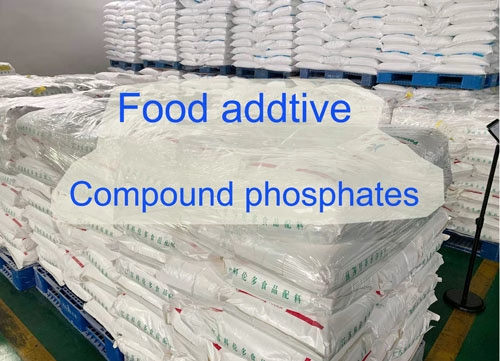I. Introduction
Compound phosphate is a very common food additive. It refers to a collective term for a certain class of chemicals, not a generalized reference to a particular chemical.

It mainly contains: sodium tripolyphosphate, sodium hexametaphosphate, sodium pyrophosphate, trisodium phosphate, disodium hydrogen phosphate, sodium acid pyrophosphate and so on. In this paper, the mechanism of action of Compound phosphate is described, and the formulation of compound phosphates and their efficacy are explained according to the type of food.
II. Types of Compound Phosphate and Mechanisms of Action
Components in compound phosphate have different roles in food processing, for example:
- Sodium tripolyphosphate: mainly used to enhance water retention and stability of food.
- Sodium hexametaphosphate: enhances dispersion and emulsification of food.
- Sodium pyrophosphate: to improve the tenderness and texture of foods
- Sodium acid pyrophosphate: mainly used as rapid fermentation agent, moisture retention agent, quality improver, to make the structure of the product fluffy, reduce the weight loss and volume shrinkage of the product.
III. Compound Phosphate Formulation in Food Processing
- Instant noodles: sodium tripolyphosphate 29%, sodium hexametaphosphate 55%, sodium pyrophosphate 4%, sodium dihydrogen phosphate 12%.
- Noodles: sodium tripolyphosphate 30%, sodium metaphosphate 55%, sodium dihydrogen phosphate 15%.
- Boiled Noodles: Sodium Pyrophosphate 20%, Potassium Pyrophosphate 30%, Sodium Dihydrogen Pyrophosphate 12%, Trisodium Phosphate 5%, Natural Substances 33
- Meat products: sodium tripolyphosphate 60%, sodium metaphosphate 22%, potassium metaphosphate 14%, sodium pyrophosphate 2%, potassium pyrophosphate 2%.
- Fish products: sodium polyphosphate 44.4%, sodium metaphosphate 22.2%, sodium pyrophosphate 11.1%, sodium dihydrogen phosphate 16.7%, sodium carbonate 5.7%.
- Sausages: potassium metaphosphate 10%, sodium metaphosphate 20%, sodium polyphosphate 40%, sodium pyrophosphate 30%.
- Ham: sodium polyphosphate 77%, sodium pyrophosphate 12.8%, disodium succinate 5%.
- Processed fish: sodium polyphosphate 37.5%, sodium pyrophosphate 37.5%, sodium ascorbate 3%, pyroalum 10%, sodium carbonate 12%.
- Candy: sodium polyphosphate 28%, sodium metaphosphate 55%, sodium pyrophosphate 17%.
- Canned fruit: sodium polyphosphate 30%, sodium metaphosphate 10%, sodium L-ascorbate 40%, DL-malic acid 20%.
- Canned meat and poultry: 85% sodium tripolyphosphate, 12% sodium hexametaphosphate, 3% sodium pyrophosphate
- Sauces and pickles: sodium polyphosphate 5%, sodium metaphosphate 25%, phosphoric acid 20%, natural substances 50%.
- Jelly: contains potassium dihydrogen phosphate and natural gels, 16% potassium dihydrogen phosphate, 84% natural gels
- Tofu: contains sodium polyphosphate, sodium metaphosphate, sodium pyrophosphate and dipotassium phosphate, with 4% sodium polyphosphate and 2% sodium pyrophosphate.
- Soft drink: contains sodium tripolyphosphate and sodium metaphosphate, of which 10% is sodium tripolyphosphate and 85% is sodium metaphosphate.
IV. Compound phosphate quality improver varieties and efficacy
| Food Name | Phosphates salts | Main effects | Recommended dosage(‰) |
| Instant noodles | Sodium acid pyrophosphate, sodium trimetaphosphate, sodium tripolyphosphate, sodium metaphosphate | Reduce the rehydration time of finished products, not sticky | ≤2.0 |
| Cookies and Cakes | Sodium acid pyrophosphate, sodium trimetaphosphate, sodium tripolyphosphate, sodium metaphosphate, calcium hydrogen phosphate, dicalcium phosphate | Shorten fermentation time, reduce product breakage rate, the gas rooms are fine and neat, can extend the storage period | ≤2.0 |
| Beverage | Phosphoric Acid, Disodium Hydrogen Phosphate, Sodium Pyrophosphate, Sodium Tripolyphosphate, Potassium Polyphosphate, Calcium Phosphate | Control acidity, integration, emulsification, stabilizer. | ≤2.0 |
| Egg white | Sodium Hexametaphosphate | Improve churning, increase foam stability | 0.05~0.2 or as needed |
| Jelly | Sodium dihydrogen phosphate, disodium hydrogen phosphate, sodium tripolyphosphate | Buffering | As needed |
| Jam | Phosphoric Acid, Sodium Hexametaphosphate | PH control, consolidation, increased yields | As needed |
| Ice cream | Disodium hydrogen phosphate, sodium pyrophosphate | Dispersion, shortens freezing time | 0.2~0.5 |
| Cooked meat products, red sausages, etc. | Disodium hydrogen phosphate, sodium pyrophosphate, sodium tripolyphosphate | Reddish color, good taste, good elasticity, high yield | 0.2~0.4 |
| Sausage | Sodium pyrophosphate acid, disodium hydrogen phosphate, sodium tripolyphosphate, sodium pyrophosphate | Accelerated processing, improved flavor, good color | 0.5 |
| Poultry | Sodium Tripolyphosphate, Sodium Pyrophosphate | Control moisture, increase yield, freshness | 0.3~0.5 or 5~6%, solution immersion |
| Processed aquatic products, fish sausages, frozen foods | Sodium tripolyphosphate, acid sodium pyrophosphate | Chelating effect, preventing crystallization, controlling moisture, inhibiting crystal formation | 6~12%, solution immersion |
| Broad beans | Disodium hydrogen phosphate, sodium tripolyphosphate, sodium hexametaphosphate | Shorten evaporation time, improve color and taste. | 0.2~0.5 |
| Ketchup | Disodium hydrogen phosphate | Improve color and luster, prevent delamination, increase yield | 0.5 |
V. The safety of compound phosphates and the dangers of overuse
- Safety: The use of compound phosphates is generally safe and will not cause harm to the human body within the scope permitted by the state.
- Hazards of overuse: Overuse of compound phosphates can lead to an imbalance in the body’s calcium-phosphorus ratio, affecting the absorption and utilization of calcium, which may lead to calcium deficiency, osteoporosis and other problems. For children, overuse may also affect the absorption of vitamin D and even cause rickets.
VI. Conclusion
From the above, it is evident that compound phosphates are very essential in food processing by improving food quality, enhancing water retention, regulating pH, and preventing food oxidation. It has a very important role in meat products, seafood, pasta products, baked goods, and beverages. Of course, excessive use will cause harm to human body, food processing enterprises should strictly abide by the relevant provisions of national laws, not to add too much. As a consumer, when choosing food, you should choose products produced by regular manufacturers in order to ensure food safety.

